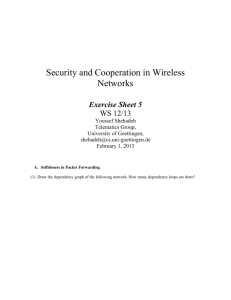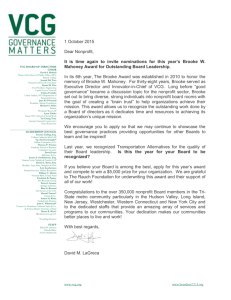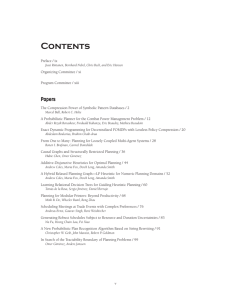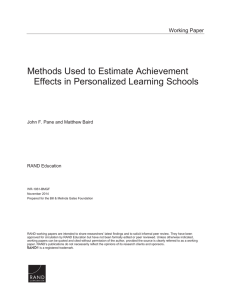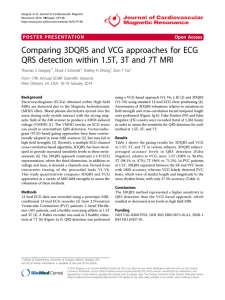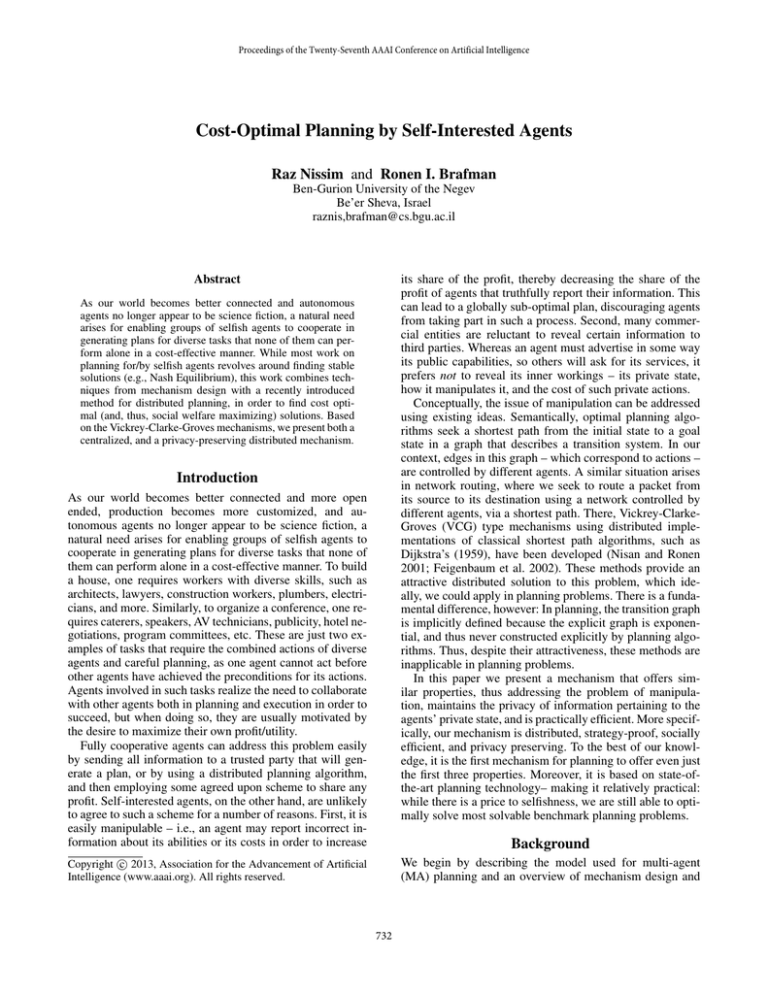
Proceedings of the Twenty-Seventh AAAI Conference on Artificial Intelligence
Cost-Optimal Planning by Self-Interested Agents
Raz Nissim and Ronen I. Brafman
Ben-Gurion University of the Negev
Be’er Sheva, Israel
raznis,brafman@cs.bgu.ac.il
Abstract
its share of the profit, thereby decreasing the share of the
profit of agents that truthfully report their information. This
can lead to a globally sub-optimal plan, discouraging agents
from taking part in such a process. Second, many commercial entities are reluctant to reveal certain information to
third parties. Whereas an agent must advertise in some way
its public capabilities, so others will ask for its services, it
prefers not to reveal its inner workings – its private state,
how it manipulates it, and the cost of such private actions.
Conceptually, the issue of manipulation can be addressed
using existing ideas. Semantically, optimal planning algorithms seek a shortest path from the initial state to a goal
state in a graph that describes a transition system. In our
context, edges in this graph – which correspond to actions –
are controlled by different agents. A similar situation arises
in network routing, where we seek to route a packet from
its source to its destination using a network controlled by
different agents, via a shortest path. There, Vickrey-ClarkeGroves (VCG) type mechanisms using distributed implementations of classical shortest path algorithms, such as
Dijkstra’s (1959), have been developed (Nisan and Ronen
2001; Feigenbaum et al. 2002). These methods provide an
attractive distributed solution to this problem, which ideally, we could apply in planning problems. There is a fundamental difference, however: In planning, the transition graph
is implicitly defined because the explicit graph is exponential, and thus never constructed explicitly by planning algorithms. Thus, despite their attractiveness, these methods are
inapplicable in planning problems.
In this paper we present a mechanism that offers similar properties, thus addressing the problem of manipulation, maintains the privacy of information pertaining to the
agents’ private state, and is practically efficient. More specifically, our mechanism is distributed, strategy-proof, socially
efficient, and privacy preserving. To the best of our knowledge, it is the first mechanism for planning to offer even just
the first three properties. Moreover, it is based on state-ofthe-art planning technology– making it relatively practical:
while there is a price to selfishness, we are still able to optimally solve most solvable benchmark planning problems.
As our world becomes better connected and autonomous
agents no longer appear to be science fiction, a natural need
arises for enabling groups of selfish agents to cooperate in
generating plans for diverse tasks that none of them can perform alone in a cost-effective manner. While most work on
planning for/by selfish agents revolves around finding stable
solutions (e.g., Nash Equilibrium), this work combines techniques from mechanism design with a recently introduced
method for distributed planning, in order to find cost optimal (and, thus, social welfare maximizing) solutions. Based
on the Vickrey-Clarke-Groves mechanisms, we present both a
centralized, and a privacy-preserving distributed mechanism.
Introduction
As our world becomes better connected and more open
ended, production becomes more customized, and autonomous agents no longer appear to be science fiction, a
natural need arises for enabling groups of selfish agents to
cooperate in generating plans for diverse tasks that none of
them can perform alone in a cost-effective manner. To build
a house, one requires workers with diverse skills, such as
architects, lawyers, construction workers, plumbers, electricians, and more. Similarly, to organize a conference, one requires caterers, speakers, AV technicians, publicity, hotel negotiations, program committees, etc. These are just two examples of tasks that require the combined actions of diverse
agents and careful planning, as one agent cannot act before
other agents have achieved the preconditions for its actions.
Agents involved in such tasks realize the need to collaborate
with other agents both in planning and execution in order to
succeed, but when doing so, they are usually motivated by
the desire to maximize their own profit/utility.
Fully cooperative agents can address this problem easily
by sending all information to a trusted party that will generate a plan, or by using a distributed planning algorithm,
and then employing some agreed upon scheme to share any
profit. Self-interested agents, on the other hand, are unlikely
to agree to such a scheme for a number of reasons. First, it is
easily manipulable – i.e., an agent may report incorrect information about its abilities or its costs in order to increase
Background
We begin by describing the model used for multi-agent
(MA) planning and an overview of mechanism design and
c 2013, Association for the Advancement of Artificial
Copyright Intelligence (www.aaai.org). All rights reserved.
732
Mechanism Design and the VCG Mechanism
VCG mechanisms.
Mechanism design deals with the problem of optimizing some criteria (e.g. social welfare), when self-interested
agents having private information are involved. In the standard (centralized) setting, agents report their private information to a “center”, which solves the optimization problem
and enforces the outcome.
The Vickery-Clarke-Groves (VCG) mechanism (Vickrey
1961; Clarke 1971; Groves 1973) is one of the most celebrated results of mechanism design. Very generally, given
the agents’ report of their private information, the center
computes an optimal solution and the payments to be made
to each of the agents. These payments reflect the impact each
agent’s participation has on other agents, and are computed
based on the solutions to the marginal problems Π−ϕi , in
which agent ϕi is completely ignored. VCG is strategyproof,
meaning that each agent’s utility-maximizing strategy regardless of other agents’ strategies and private information is
to truthfully reveal its private information to the center. Strategyproofness implies that the agents don’t need to model
the behavior of others in order to compute their equilibrium
strategy – truth telling is a weakly dominant strategy. VCG
is also efficient, meaning that the outputted solution maximizes the total utility to agents over all possible solutions to
Π. Both these properties prove useful when applying VCG
to our setting of cost-optimal MA planning.
Planning for Self-Interested Agents
The framework we chose for our work is the MA - STRIPS
model (Brafman and Domshlak 2008). This framework minimally extends the classical STRIPS problem to MA planning for cooperative agents. The main benefits of using this
model are its simplicity, and the fact that it is easily extended
to handle the case of non-cooperative agents.
Definition 1. A MA-STRIPS planning task for a set of fully
cooperative agents Φ = {ϕi }ki=1 is given by a 4-tuple Π =
(P, {A}ki=1 , I, G) with the following components:
• P is a finite set of atomic propositions, I ⊆ P encodes
the initial state and G ⊆ P encodes the goal conditions.
• For 1 ≤ i ≤ k, Ai is the set of actions that the agent
S ϕi is
capable of performing, and each action a ∈ A = Ai is
given by its preconditions and effects, as well as its cost.
A solution to a planning task is a legal plan π =
(a1 , . . . , ak ) which transforms the initial state into a state
satisfying the goal conditions. A solution is optimal if it has
minimal cost (sum of action costs) over all solutions.
Given the partitioning of the actions, we can now distinguish between private and public atoms and actions. A private atom of agent ϕ is required and affected only by the
actions of ϕ. An action is private if all its preconditions and
effects are private. All other actions are classified as public.
That is, ϕ’s private actions affect and are affected only by
ϕ, while its public actions may require or affect the actions
of other agents. Note that this implies the public action of
an agent may have private preconditions and/or effects. For
ease of the presentation of our algorithms and their proofs,
we assume all goal conditions are public, thus all actions that
achieve a goal condition are considered public as well. Our
methods are easily modified to remove this assumption.
Extending MA - STRIPS from fully-cooperative agents to
self-interested agents does not require changing the model
itself, but rather changing how it is used, and how information is distributed to different agents. We think of the public
part of public actions (i.e., public preconditions and effects)
as the interface of the agent to the external world – the information it advertises to the external world. The private aspects of public actions, the private variables, and the private
actions and their cost is information that agents do not advertise, e.g., because it reveals information about their internal
operation that may be useful to competitors, or because of
other privacy issues.
Since the self-interest of agents requires defining their
utility functions, we make the standard assumption of quasilinear utility functions, where agent ϕi ’s net utility, given
plan π and payments P, is
Related Work
Our work relates to two research areas: Multi-agent/
distributed planning and mechanism design for decision
making in systems of self-interested agents. We now survey
relevant results in both areas.
Recently, several methods for planning in the cooperative
setting of MA - STRIPS have been presented. Planning-First
(Nissim, Brafman, and Domshlak 2010), a distributed MA
planner based on the Planning as CSP+Planning methodology (Brafman and Domshlak 2008), showed scalability in
problems having loosely coupled agents. More recently, an
approach which uses plan refinement (Torreño, Onaindia,
and Sapena 2012), showed state-of-the-art performance in
more tightly coupled problems. We note that both methods
are privacy preserving, but do not guarantee cost-optimal solutions (Planning-First minimizes the maximal number of
public actions in an agent’s plan).
Tackling the strategic side of MA planning, work has
been done on achieving equilibria by a strategic diagnosis
of the planning scenario by the agents (Bowling, Jensen,
and Veloso 2003; Ben Larbi, Konieczny, and Marquis 2007).
This work attempts to find strategies (plans) for the agents
which constitute a Nash Equilibrium, by performing strategic analysis of all possible agent plans. This analysis, where
every strategy of every agent must be evaluated against all
other strategies, makes these methods ineffective for planning, since even if plan length is bounded polynomially
(not the case for many planning benchmarks), the number
of available strategies is exponential. This problem pertains
to all such “pure” game-theoretic approaches requiring the
agents to perform some strategic evaluation of other agents.
ui (π, P) = Pi − costi (π)
where Pi is the payment given to agent ϕi for its participation and costi (π) denotes the sum of the costs of all actions
by agent ϕi in π. Finally, we assume that no collusion between agents occurs. This also implies that an agent cannot
pretend to be several independent agents.
733
In light of this, further work has been done on feasibility conditions of MA planning for selfish agents, aiming
to find stable solutions in problems exhibiting certain structure – acyclic agent interaction graph (Brafman et al. 2009;
2010), and safe interaction, where no agent benefits from invalidating another agent’s plan (Crosby and Rovatsos 2011).
Furthermore, work has been done on using single-agent
planners in order to perform plan improvement using bestresponse, in scenarios where an initial MA plan is available
(Jonsson and Rovatsos 2011). We note that all the mentioned
approaches do not aim to find an optimal solution.
In the field of mechanism design, much work has been
done on using centralized incentive mechanisms for distributed systems (Ephrati and Rosenschein 1991; Parkes,
Kalagnanam, and Eso 2001). The problem of lowest-cost
routing on the Internet provided the motivation for work
on distributed algorithmic mechanism design (Feigenbaum
et al. 2002; Feigenbaum and Shenker 2002). This work
presents distributed protocols for computing all-pairs leastcost routes, where the links are associated to strategic agents.
The assumption here is that the graphs are given, and are
small (one node per agent), since the algorithms require
memory polynomial in graph size. This assumption means
these methods cannot be used in the planning setting, where
the graphs are implicit and exponentially large. The main
advantage of these works was that the agents could not benefit by misreporting their costs, so no strategic analysis is
required by the agents. Later work (Parkes and Shneidman
2004) discussed the robustness of the algorithm itself to manipulation, and introduced the principles required for achieving an incentive compatible distributed mechanism. These
principles are discussed in further detail later on.
Based on these results, the first faithful distributed implementation of efficient social choice problems (M-DPOP)
was presented (Petcu, Faltings, and Parkes 2008). M-DPOP
is a distributed constraint optimization algorithm implementing the VCG mechanism. It ensures that no agent can
benefit by deviating from any part of the distributed protocol. While M-DPOP can be used to solve planning problems, which can be cast as DCOPs, previous work (Nissim, Brafman, and Domshlak 2010; Nissim and Brafman
2012a) shows that distributed planning algorithms, especially ones using heuristic forward search, have strong computational benefits, whereas CSP-based methods can barely
handle problems that require 3 or more actions per agent.
3. Each agent receives payment
X
?
Pi =
(costj (π−ϕ
) − costj (π ? ))
i
j6=i
In this setting, each agent reports its actions and their costs
to the center, which then computes the payment rule, i.e.
the payments made to each of the agents for participating in
the mechanism. The payment of each of the agents is determined by the center according to the agent’s social cost – the
aggregate impact its participation has on the utilities of other
agents. To compute the payments, the center needs to solve
Π, as well as the marginal problems Π−ϕi for each ϕi ∈ Φ.
Note that the payments are always non-negative, since an
agent’s presence may only have a positive effect on solution cost. Therefore, a pivotal agent ϕi , i.e. one which improves solution cost by participating, will have Pi > 0 and
will be paid for its participation, whereas non-pivotal agents
will pay exactly 0. This means the center will run a budgetdeficit (i.e. will never make a profit), but no agent will lose
by participating. This deficit can be viewed as the agents’
profit from taking part in the plan. In a market where numerous agents can perform similar actions at different costs,
e.g., due to efficiency differences, proximity, availability of
resources, etc., the profit is related to such advantages that
one agent may have over others. Note that in this schema,
an agent that is essential (i.e., no solution exists without it)
will receive a payment of ∞, so the underlying assumption
is that no such agent exists.
As an example, consider the well-known logistics planning domain, which involves vehicles transporting packages
to their goal location. Each of the three agents ϕ1 . . . ϕ3 can
pickup/drop one of two packages p1 , p2 , and can drive between two locations A, B. Initially, both packages and the
three agents are at location A, and the goal is to move both
packages to location B. Action costs differ between agents:
ϕ1 ’s pickup/drop actions have cost 1 for p1 , and cost 2 for
p2 . ϕ2 ’s pickup/drop actions have cost 2 for p1 , and cost 1
for p2 . ϕ3 ’s pickup/drop actions have cost 2 for both p1 , p2 .
All drive actions have cost 1.
Given the report of actions costs, the center now finds an
optimal plan having cost 6, in which ϕ1 , ϕ2 pickup, drive
and drop packages p1 , p2 , respectively. For the marginal
problems Π−ϕ1 and Π−ϕ2 , the optimal solution has cost 8.
Therefore, P1 = P2 = 8 − 3 = 5. This gives the two pivotal
agents the positive utility u1 = u2 = 5 − 3 = 2. For the
non-pivotal agent ϕ3 , Π−ϕ3 has an optimal solution cost of
6, therefore its payment (and its utility) will be 0.
Centralized VCG Mechanism for Planning
To set the stage for our distributed mechanism, we now describe how to apply the VCG mechanism to our setting of
optimal MA planning, when a trusted center exists:
Definition 2 (VCG mechanism for optimal MA planning). Given a MA planning problem Π in which agents are
self-interested and have private information, the mechanism
is as follows:
1. Agents report their private actions and all action costs to
the center.
2. Given the agents’ reports, the center finds an optimal so∗
lution π ? for Π, as well as π−ϕ
for each Π−ϕi .
i
Distributed Implementation of VCG
While the centralized approach finds the optimal solution,
maximizes social welfare, and ensures truthfulness of the
agents, in many cases it will be impossible to find a trusted
central authority. Moreover, even if one exists, this centralized approach is not privacy preserving, as agents must reveal their private information to the center.
A desirable alternative is a distributed implementation of
the VCG mechanism that computes the payments, solves Π,
while maintaining some sense of VCG’s strategyproofness.
734
the last action performed leading up to s3 . When agent ϕ
receives a state via a message, it checks whether this state
exists in its open or closed lists. If it does not appear in these
lists, it is inserted into the open list. If a copy of this state
with higher g value exists, its g value is updated, and if it is
in the closed list, it is reopened. Otherwise, it is discarded.
Whenever a received state is (re)inserted into the open list,
the agent computes its local hϕ value for this state, and assigns the maximum of its hϕ value and the h value in the
received message.
Once an agent expands a solution state s, it sends s to all
agents and initiates the process of verifying its optimality.
When the solution is verified as optimal, the agent initiates
the trace-back of the solution plan. This is also a distributed
process, which involves all agents that perform some action
in the optimal plan. When the trace-back phase is done, a
terminating message is broadcasted.
Algorithms 1-3 depict the MAD-A* algorithm for agent
ϕi . Unlike in A*, expansion of a goal state in MAD-
However, such a distributed implementation introduces new
opportunities for agent manipulation, as in addition to reporting its private information untruthfully, an agent may
deviate from the distributed protocol, unless the right incentives for following the protocol are provided. We present
such an implementation next.
In describing our distributed implementation, we make
the following assumptions1 , in addition to the ones made in
the background section:
1. There is a trusted bank which can communicate with the
agents and distribute payments.
2. The agents are rational but helpful, i.e. they are selfinterested, but will deviate from a protocol only if this
makes them strictly better off.
3. Every agent can communicate directly with all other
agents.
4. The bank may rescind payment if a legal, goal-achieving
plan is not found and executed.
Work by Parkes and Shneidman (2004) describes principles that guide the distribution of computation, focusing in
particular on the VCG mechanism. A distributed algorithm
(protocol) is said to be ex post faithful if it is in the best
interest of every agent to truthfully follow all aspects of the
algorithm (information revelation, message passing, computation, etc.) regardless of other agents’ private information,
given that all other agents follow the algorithm2 . An algorithm is said to satisfy the Partition Principle if (1) optimal
solutions are always obtained for Π and Π−ϕi , given that
all agents fully comply with the suggested distributed protocol; (2) agent ϕi cannot affect the distributed computation
of the marginal problem Π−ϕi , nor its utility from the outcome; (3) the solution found for Π is correctly executed and
the payments are made to the agents. Parkes and Shneidman
show that a distributed algorithm that satisfies the partition
principle is ex post faithful.
Algorithm 1 MAD-A* for Agent ϕi
1: while did not receive true from a solution verification
procedure do
2:
for all messages m in message queue do
3:
process-message(m)
4:
s ← extract-min(open list)
5:
expand(s)
Algorithm 2 process-message(m = hs, gϕj (s), hϕj (s)i)
1: if s is not in open or closed list or gϕi (s) > gϕj (s)
then
add s to open list and calculate hϕi (s)
gϕi (s) ← gϕj (s)
hϕi (s) ← max(hϕi (s), hϕj (s))
2:
3:
4:
A* does not necessarily mean an optimal solution has been
found. Here, a solution is known to be optimal only if all
agents prove it so. Intuitively, a solution state s having solution cost f ∗ is known to be optimal if there exists no state
s0 in the open list or the input channel of some agent, such
that f (s0 ) < f ∗ . In other words, solution state s is known to
be optimal if f (s) ≤ flower−bound , where flower−bound is a
lower bound on the f -value of the entire system, including
all states in open lists and states in unprocessed messages.
To detect this situation, MAD-A* uses Chandy and Lamport’s snapshot algorithm (Chandy and Lamport 1985),
which enables a process to create an approximation of the
global state of the system, without “freezing” the distributed
computation. Although there is no guarantee that the computed global state actually occurred, the approximation is
The MAD-A* Algorithm
We now describe the distributed protocol which we use
for the VCG computations. At its heart is a distributed
planning algorithm: MAD-A* (Nissim and Brafman 2012a;
2012b) is a distributed, privacy-preserving variation of A*,
which maintains a separate search space for each agent.
Each agent maintains an open list of states that are candidates for expansion and a closed list of already expanded
states. It expands the state with the minimal f = g + h value
in its open list. When an agent expands state s, it uses its
own actions only. This means that two agents expanding the
same state will generate different successor states.
The messages sent between agents contain the full state
s, i.e., including both public and private variable values, as
well as the cost of the best plan from the initial state to s
found so far, the sending agent’s heuristic estimate of s and
3
It may appear that agents are revealing their private data because they transmit their private state in their messages. However,
as will be apparent in the algorithm, other agents do not use this
information in any way, nor alter it. They simply copy it to future
states. Only the agent itself can change the value of its private state.
Consequently, this data can be encrypted arbitrarily – it is merely
used as an ID by other agents.
1
similar to the ones made by Petcu et al. (2008)
The weakening of VCG’s strategyproofness in the centralized
case, to ex post faithful in the distributed case is often referred to
as the cost of decentralization.
2
735
Proof of Correctness
Algorithm 3 expand(s)
1: move s to closed list
2: if s is a goal state then
3:
broadcast s to all agents
4:
initiate verification of stable property flower−bound ≥
gϕi (s)
5:
return
6: for all agents ϕj ∈ Φ do
7:
if the last action leading to s was public and ϕj has a
public action for which all public preconditions hold
in s then
8:
send s to ϕj
9: apply ϕi ’s successor operator to s
10: for all successors s0 do
11:
update gϕi (s0 ) and calculate hϕi (s0 )
12:
if s0 is not in closed list or fϕi (s0 ) is now smaller than
it was when s0 was moved to closed list then
13:
move s0 to open list
In order to prove the correctness of algorithm 4, we must
prove that it satisfies the partition principle (Parkes and
Shneidman 2004). Therefore, we must show that (1) MADA* computes optimal solutions to Π and Π−ϕi for all ϕi ∈
Φ, given that all agents comply with the protocol; (2) No
agent can affect the solution of its respective marginal problem, nor its utility from the outcome; (3) the optimal solution
of Π is correctly executed and all payments are made.
Condition (1) follows immediately from the correctness
and optimality of MAD-A*, which requires only that the
heuristic used by each of the agents is consistent. The first
part of condition (2) holds since agent ϕi does not even par∗
, and therefore, cannot influticipate in the solving of π−ϕ
i
ence it in any way. For the second part, agent ϕi ’s utility
ui (Π) is given by
X
?
Pi −costi (π ? ) =
)−costj (π ? ))−costi (π ? )
(costj (π−ϕ
i
j6=i
?
= cost(π−ϕ
) − cost(π ? )
i
good enough to determine whether a stable property currently holds in the system. A property of the system is stable
if it is a global predicate which remains true once it becomes
true. Specifically, properties of the form flower−bound ≥ c
for some fixed value c, are stable when h is a globally consistent heuristic function. That is, when f values cannot decrease along a path. In our case, this path may involve a
number of agents, each with its h values. If each of the local functions hϕ are consistent, and agents apply the max
operator when receiving a message, this property holds.
?
Since ϕi cannot influence cost(π−ϕ
), it can have a posii
tive influence on its utility only by decreasing cost(π ? ). As
π ? is already optimal, any such decrease means either that
other agents’ costs have been decreased, which will cause
the plan to fail (some agent will not agree to such a solution)
and the payments to be rescinded, or that ϕi misreported
its own costs, which does not change its actual utility. Condition (3) follows directly from our assumption that there
exists a trusted bank, which can rescind payments if a legal
plan is not executed.
We have shown that Selfish-MAD-A* satisfies the partition principle, and therefore, it is ex post faithful.
Distributed Implementation
Consider now our distributed implementation of VCG which
uses the MAD-A* algorithm, presented as Algorithm 4. In
this setting, the agents participate in |Φ|+1 sequential MADA* searches, beginning with the original problem Π, and
continuing with the marginal problems Π−ϕi for each i.
When solving the marginal problem Π−ϕi , messages from
ϕi are ignored by all agents, and no messages are sent to it.
Once each of the marginal problems Π−ϕi are solved, each
∗
. This
agent ϕj 6= ϕi knows its local cost in π ∗ and in π−ϕ
i
is sufficient in order to send the value Pij , that is, the cost
removing ϕi incurs on ϕj , to the bank. Upon receiving all
these messages, the bank is able to compute P. Since MADA* does not require the agents to reveal their private information, Algorithm 4 is automatically privacy preserving.
Optimizing Selfish-MAD-A* by Multigoal Search
In the distributed implementation presented in the previous
section, each of the |Φ| + 1 problems is solved in isolation.
It is clear that when these problems are solved, the generated search spaces overlap, causing some states to be generated (and evaluated) multiple times. For example, in Π−ϕi ,
?
all reachable states s having f (s) ≤ cost(π−ϕ
) must be
i
expanded. In Π, all these states are reachable, and will be
expanded as well.
In order to prevent the duplication of effort Selfish-MADA* entails, we propose a multigoal variation of MAD-A*,
which finds optimal solutions to all |Φ| + 1 problems in a
single run and on a single (distributed) search space. The
main idea is to additionally identify each state s with the set
of agents participating in the (currently) best plan leading
up to s. If s can be reached via two paths having different participating agents sets, s is duplicated. When a goal
state s? is reached, it is treated as a candidate solution for
Π−ϕi if ϕi does not participate in the path leading to s? .
Termination detection remains unchanged, except that it is
performed for each marginal problem, as well as for Π.
s? is known to be optimal for marginal problem Π−ϕi , if
i
i
f (s? ) ≤ flower−bound
, where flower−bound
is a lower bound
on the f -value of all states for which ϕi does not participate
Algorithm 4 Selfish-MAD-A*
1: Run MAD-A* on Π with all agents in Φ to find π ?
2: for all ϕi ∈ Φ do
∗
3:
Run MAD-A* on Π−ϕi to find π−ϕ
i
?
4:
Agents ϕj 6= ϕi compute Pij = costj (π−ϕ
)−
i
?
costj (π ) and send it to the
bank.
P
5:
The bank computes Pi = j6=i Pij
6: Bank pays Pi to every agent ϕi , and broadcasts π ? to all
agents.
736
high – most problems are solved in roughly the same time,
with a few exceptions solved 4 and 16 times slower. This is
because solving the marginal problems is fairly easy once
an optimal solution has been found. However, the cost of
privacy is much higher – most problems are solved 4 times
slower than centralized VCG, with one problem solved 18
times slower. This is mainly because the privacy of information hurts the heuristic quality, an important factor in the
effectiveness of forward search (heuristic) algorithms. However, given that the distributed configurations solve a more
difficult problem than the centralized ones, this slowdown
is expected and acceptable. Comparing the two distributed
approaches, we see that the optimized multigoal version
dominates Selfish-MA-A* w.r.t. both runtime and generated
nodes. It is clear that elimination of the duplicate effort has
a positive effect computation-wise.
Table 1: Comparison of centralized A*, centralized VCG,
and two versions of distributed VCG. Running time (in sec.)
and the number of generated states are shown.
Problem
rovers6 (2)
rovers7 (3)
rovers12 (4)
satellite5 (3)
satellite6 (3)
satellite7 (4)
transport2 (2)
transport3 (2)
transport4 (2)
zenotravel8 (3)
zenotravel9 (3)
zenotravel10 (3)
zenotravel11 (3)
A*
278
0.7
1
0.06
0.4
2.96
0.01
3.68
40.4
0.06
20.8
56.8
2.22
Time (sec.)
Cen Dis OptDis
282.5 324
290
2.78 6.62
5.1
16.7 102.1
67.2
0.06 2.78
1.1
0.4 4.67
2.16
2.98 31.9 11.04
0.02 0.2
0.12
12.1 42.7
33.2
52.2 1036
712
0.08 0.66
0.32
45.4 835.7
611
375
X
X
2.4 22.4
14.8
A*
34M
62271
55783
2817
39182
246762
166
27354
112824
725
227670
539895
24094
Generated states
Cen
Dis
35M
114M
316553 2262129
1306970 29412049
2961 1928245
39384 3311637
246902 25675038
290
10626
120256 2583063
154469 24543906
1009
46282
538352 44768124
4287493
X
26332 1490640
OptDis
102M
2104573
24506767
932233
1763072
10208671
8874
2207614
22787598
26560
35520708
X
1126475
Discussion
We described a distributed, strategy-proof, socially efficient,
and privacy preserving mechanism for planning by a group
of self-interested agents. This result contributes to a small,
but growing body of research on this topic. One important
advantage of our mechanism is its efficiency. Although there
is a clear computational cost to selfishness, we can optimally
solve the same order of problems as state-of-the-art optimal planning algorithms. This is in stark contrast to most
alternatives: work on stable planning relies on CSP-based
algorithms discussed by Nissim, Brafman and Domshlak
(2010), that have difficulty handling plans that require more
than 3 public actions per agent and do not generate optimal plans, whereas work that seeks equilibria either does not
consider the issue of privacy, assumes truthfulness ignoring
the issue of manipulation, or requires costly computations.
The VCG mechanism is not without faults. Its main weakness is the the fact that the side payments that the plan beneficiary has to pay the agents can be very substantial in theory. This makes the mechanism suitable in two contexts: 1)
Competitive environments where there are a number of different agents with similar capabilities and similar costs, in
which case the payments agents receive are not significantly
beyond their true cost. Thus, in the example of building construction, there is a large number of providers for every possible task, some more efficient or appropriate (e.g., because
their proximity to the site lowers their costs), but all in the
same ball park. 2) Plan beneficiary for which the benefit of
optimality far outweighs the cost paid. For example, road
construction by local government, where the time to complete the project outweighs other considerations. How to address the issue of overcharging is the subject of much current
work on related problems (Elkind, Sahai, and Steiglitz 2004;
Karlin, Kempe, and Tamir 2005; Singer 2010), although
none of the current results are applicable to the planning settings. We hope to examine this question in future work.
in their currently best plan. Once all |Φ| + 1 solutions are
verified, the algorithm terminates. To further optimize the
algorithm, states that are irrelevant for remaining marginal
searches can be pruned, reducing computational effort.
Since all |Φ| + 1 are now solved on a single, albeit distributed, search space, this presents a new possibility of manipulation, having ϕi influencing the solution of Π−ϕi . To
avoid this, and to retain property (2) of the partition principle, a state arriving via message from ϕi is automatically
considered to have ϕi in its participating agents, and thus
never to be considered as a candidate solution for Π−ϕi .
Empirical Evaluation
We performed an empirical evaluation on several MA planning benchmark domains taken from the International Planning Competition . We compare the computational effort required by centralized A* and our two mechanisms (centralized and distributed). We refer to the overhead of computing
the centralized mechanism (compared to centralized A*) as
the cost of selfishness, and to the computational overhead of
distributing the mechanism as the cost of privacy. We show
that empirically, these costs are not high, providing evidence
of the feasibility of our methods.
Table 1 depicts the running time and the number of generated states of A* (solving the underlying classical planning
problems with full knowledge) and the 3 VCG mechanisms
– Centralized (Cen), Selfish-MAD-A* (Dis), and optimized
multigoal Selfish-MAD-A* (OptDis). All planners were implemented on top of the Fast-Downward planning system
(Helmert 2006) and use the state-of-the-art LM-cut heuristic (Helmert and Domshlak 2009). The number of agents is
given in parentheses in the Problem column. We note that
the two centralized configurations use the pruning method
described by Nissim et al. (2012), which simulates the computational benefits of MAD-A* in centralized search. This
is done so MAD-A* wouldn’t have an advantage, giving an
accurate view of the costs of selfishness and privacy. Running time was limited to 30 minutes and memory to 4GB.
In most cases, the cost of selfishness (overhead incurred
by the centralized computation of the VCG payments) is not
Acknowledgments
The authors were partly supported by the Paul Ivanier Center
for Robotics Research and Production Management, and the
Lynn and William Frankel Center for Computer Science.
737
References
Nissim, R., and Brafman, R. I. 2012b. Multi-agent A* for
parallel and distributed systems. In ICAPS Workshop on
Heuristics and Search for Domain-Independent Planning,
43–51.
Nissim, R.; Apsel, U.; and Brafman, R. I. 2012. Tunneling
and decomposition-based state reduction for optimal planning. In ECAI, 624–629.
Nissim, R.; Brafman, R. I.; and Domshlak, C. 2010. A
general, fully distributed multi-agent planning algorithm. In
AAMAS, 1323–1330.
Parkes, D. C., and Shneidman, J. 2004. Distributed implementations of Vickrey-Clarke-Groves mechanism. In AAMAS, 261–268. IEEE Computer Society.
Parkes, D. C.; Kalagnanam, J.; and Eso, M. 2001. Achieving budget-balance with Vickrey-based payment schemes in
exchanges. In IJCAI, 1161–1168. Morgan Kaufmann.
Petcu, A.; Faltings, B.; and Parkes, D. C. 2008. M-DPOP:
Faithful distributed implementation of efficient social choice
problems. J. Artif. Intell. Res. (JAIR) 32:705–755.
Singer, Y. 2010. Budget feasible mechanisms. In FOCS,
765–774.
Torreño, A.; Onaindia, E.; and Sapena, O. 2012. An approach to multi-agent planning with incomplete information. In ECAI, volume 242, 762–767. IOS Press.
Vickrey, W. 1961. Counterspeculation, Auctions and Competitive Sealed Tenders. Journal of Finance 8–37.
Ben Larbi, R.; Konieczny, S.; and Marquis, P. 2007. Extending classical planning to the multi-agent case: A gametheoretic approach. In European Conference on Symbolic
and Quantitative Approaches to Reasoning with Uncertainty, ECSQARU, 731–742.
Bowling, M. H.; Jensen, R. M.; and Veloso, M. M. 2003.
A formalization of equilibria for multiagent planning. In
IJCAI, 1460–1462.
Brafman, R. I., and Domshlak, C. 2008. From one to
many: Planning for loosely coupled multi-agent systems. In
ICAPS, 28–35.
Brafman, R. I.; Domshlak, C.; Engel, Y.; and Tennenholtz,
M. 2009. Planning games. In IJCAI, 73–78.
Brafman, R. I.; Domshlak, C.; Engel, Y.; and Tennenholtz,
M. 2010. Transferable utility planning games. In AAAI.
Chandy, K. M., and Lamport, L. 1985. Distributed snapshots: Determining global states of distributed systems.
ACM Trans. Comput. Syst. 3(1):63–75.
Clarke, E. H. 1971. Multipart pricing of public goods. Public Choice 2:19–33.
Crosby, M., and Rovatsos, M. 2011. Heuristic multiagent
planning with self-interested agents. In AAMAS, 1213–1214.
Dijkstra, E. W. 1959. A note on two problems in connexion
with graphs. Numerische Mathematik 1:269–271.
Elkind, E.; Sahai, A.; and Steiglitz, K. 2004. Frugality in
path auctions. In SODA, 701–709.
Ephrati, E., and Rosenschein, J. S. 1991. The Clarke Tax as
a consensus mechanism among automated agents. In AAAI,
173–178.
Feigenbaum, J., and Shenker, S. 2002. Distributed algorithmic mechanism design: recent results and future directions.
In DIAL-M, 1–13. ACM.
Feigenbaum, J.; Papadimitriou, C. H.; Sami, R.; and
Shenker, S. 2002. A BGP-based mechanism for lowest-cost
routing. In PODC, 173–182. ACM.
Groves, T. 1973. Incentives in Teams. Econometrica
41:617–631.
Helmert, M., and Domshlak, C. 2009. Landmarks, critical
paths and abstractions: What’s the difference anyway? In
ICAPS.
Helmert, M. 2006. The Fast Downward planning system. J.
Artif. Intell. Res. (JAIR) 26:191–246.
ICAPS.
The International Planning Competition.
http://www.plg.inf.uc3m.es/ipc2011-deterministic/.
Jonsson, A., and Rovatsos, M. 2011. Scaling up multiagent
planning: A best-response approach. In ICAPS.
Karlin, A. R.; Kempe, D.; and Tamir, T. 2005. Beyond
VCG: Frugality of truthful mechanisms. In FOCS, 615–
626.
Nisan, N., and Ronen, A. 2001. Algorithmic mechanism
design. Games and Economic Behavior 35(1-2):166–196.
Nissim, R., and Brafman, R. I. 2012a. Multi-agent A* for
parallel and distributed systems. In AAMAS, 1265–1266.
738

